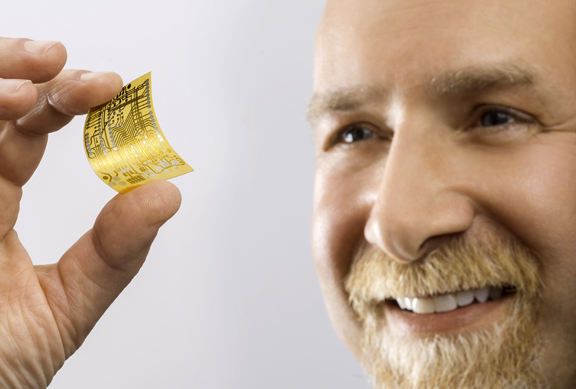SolidWorks World 2016: Design Shifts from Geometry to Data, Wires, and Chips

3D-printed PCB chip, printed in Nano Dimension’s DragonFly printer.
Latest News
February 17, 2016
 SolidWorks PCB, the outcome of a partnership between SolidWorks and PCB design software maker Altium.
SolidWorks PCB, the outcome of a partnership between SolidWorks and PCB design software maker Altium. 3D-printed PCB chip, printed in Nano Dimension’s DragonFly printer (photo courtesy of Yorum Reshef)
3D-printed PCB chip, printed in Nano Dimension’s DragonFly printer (photo courtesy of Yorum Reshef)Lou Feinstein who currently manages SolidWorks’ portfolios for IoT, PCB (printed circuit boards), electrical, mechatronics and plastronics, initially had some doubts about his role inside the SolidWorks organization. He remembered the first time SolidWorks approached him with a job offer.
“They called me many times. I said, You’re SolidWorks. You do mechanical (MCAD). I’m an electrical (ECAD) guy. What do you need me for?”
Feinstein previously held positions at Textron Systems, which serves the aircraft, defense, industrial, and finance sectors; EMC2, a data storage and security vendor; and Lucent, a telecom solutions provider. The combination of his expertise from IT, electrical design, and data made him a logical fit for a mechanical CAD company that must prepare itself for the era of IoT, he eventually came to realize.
The MCAD-ECAD Codesign Environment
“The final frontier for IoT is the electro-mechanical interface” explained Feinstein. “That helps us get tight geometry in really complex designs. Today’s [ECAD-MCAD collaboration tools] use neutral formats that are the equivalent of STEP files. What we want is a solution that doesn’t require translation.”
The outcome of SolidWorks’ initiative to incorporate PCB design, revealed at the most recent SolidWorks World user conference (SWW16), is SolidWorks PCB. The new product merges popular ECAD software maker Altium’s technology with SolidWorks technology. With this approach, the product can read and edit SolidWorks mechanical files and Altium electrical design files in their native formats with no translation.
“You don’t need to worry about translation loss, no need for reorienting the different zero positions,” said Feinstein. “Now, we can raise the level of [MCAD-ECAD] simulation possible.”
PCB-Embedded Parts
When PCB design was simple, MCAD could accommodate it with simple space allocation—a square box reserved for PCB in the overall mechanical structure. But the fitting gets more complex when flexible, bendable, origami-like PCBs enter the market. (For more, read “Don’t Throw It Over the Wall,” February 2016.)
On that front, SolidWorks’ latest partner Nano Dimension is poised to break new grounds. The DragonFly 2020 3D Printer, demonstrated at SWW16, combines “inkjet deposition system, advanced nano chemistry, and sophisticated software to print rapid prototypes of professional multilayer printed circuit boards in-house, more quickly and less expensively than outsourcing,” according to Nano Dimension’s press release.
The company explains that it uses a highly conductive ink, which “
The ability to make PCB part of the plastic—not a separate component that must be attached to the plastic—goes along way to advance IoT design development. Infusing PCBs into plastic parts could drastically reduce the number of electrical components in products. Furthermore, it opens doors to new interface possibilities in connected personal devices.
Data Harvesting
IoT devices work best when their functions are augmented by data-driven apps—an area that a company like SolidWorks lacks domain expertise. To fill the gap, SolidWorks struck up a partnership with LogMeIn, an enterprise IoT platform provider. The joint-announcement reads, “the partnership will give product companies a complete solution for designing, building, running, and supporting a truly connected business.”
LogMeIn’s IoT platform is dubbed Xively. According to its makers, Xively “enables companies to develop, build, and securely connect new products, manage data from their usage, and engage more closely with their customers in a deeper, more valuable, relationship.”
Suchit Jain, SolidWorks’ VP of strategy, community & business development, said, “The reality for most traditional product companies is that connecting a product to the internet adds an entirely new layer of complexity to the design process. While these companies excel in product design and engineering, creating IoT-enabled products includes a technology component with web and application integration—concepts that are all but foreign to many product companies.”
In the last few years, SolidWorks and its rivals in the MCAD business see the looming shadow of IoT, a trend that demands much more than 3D geometry construction. Some like PTC prepares for it by refashioning itself as an IoT company, through a mix of acquisitions and in-house R&D initiatives. Once known primarily for its mechanical CAD program, SolidWorks now takes bold steps into the real of IoT with new products and partnerships.
Subscribe to our FREE magazine, FREE email newsletters or both!
Latest News
About the Author
Kenneth Wong is Digital Engineering’s resident blogger and senior editor. Email him at [email protected] or share your thoughts on this article at digitaleng.news/facebook.
Follow DE





